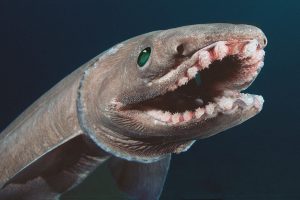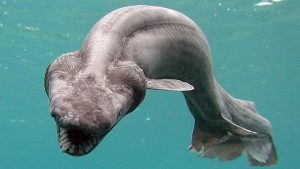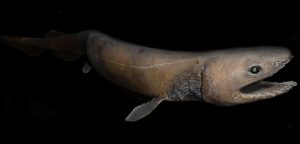The frilled shark is a strange, prehistoric-looking shark that lives in the open ocean and spends much of its time in deep, dark waters far below the sea surface. Its long, cylindrical body reaches lengths of nearly 7 feet (2 m), and its fins are placed far back on the body. The frilled shark gets its name from the frilly appearance of its gill slits.

Frilled sharks are active predators and may lunge at potential prey, swallowing it whole, even if it is quite large. Their normal swimming style, however, is distinctly eel-like, as they swim in a serpentine fashion. The preferred prey of the frilled shark is squid, and they have several rows of long teeth, each with three long points, that are perfect for snagging the soft bodies of this prey. Though they specialize on squids, frilled sharks are known to eat a variety of fishes and also other sharks.
Frilled sharks are only very rarely encountered in the wild, so little is known about their ecology. The limited information that scientists do have is based on dissection of individuals captured in deep-sea net fisheries and observation of the occasional live individual in captivity. Frilled sharks reproduce via internal fertilization and give live birth. However, they do not connect to their young through a placenta, like in most mammals. Instead, embryos live off of energy obtained from yolk sacs, and only after the juveniles are able to survive on their own does the mother give birth to her young.


Little is known about the population trends of frilled sharks, but they are rarely encountered by humans and are likely naturally rare. In some places they are accidentally caught as bycatch in fisheries targeting other species, and in these cases, they may be kept and used as food. No fisheries specifically target frilled sharks. Experts – as a result of their natural rarity and occasional capture in some fisheries – consider the frilled shark to be ‘near threatened’ with extinction.
The first description of this shark dubbed it an “elusive creature, the serpent-like monster of the oceans.” Frilled sharks can grow up to six feet long with 25 rows of teeth. These teeth face inward, ensuring once prey get in, they don’t get out. No one has seen a frilled shark eat so we’re not sure how their prey meets their fate. Possibly they are lured near by the shark’s white chompers and are done in by a quick and powerful lunge forward that seal’s their fate.
Female frilled sharks are larger than males. These powerful mamas may have the longest gestation period on earth: 42 months. That’s over three years of carrying around an average of six pups in their bellies. While in the womb, they do not have a placenta like human babies, but live in egg capsules, nourished by the yolk.
Glimpses of frilled sharks are rare. In 2015 an Australian fisherman caught one and described the experience as something out of a horror movie. If all this talk about this scary shark is making you nervous to dip your toe into the ocean waves, don’t worry. These sharks typically live hundreds or even thousands of feet below the surface. The average person will be able to see a frilled shark only in pictures … or in your nightmares.
